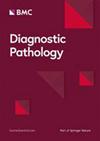Utilizing deep learning model for assessing melanocytic density in resection margins of lentigo maligna
IF 2.4
3区 医学
Q2 PATHOLOGY
引用次数: 0
Abstract
Surgical excision with clear histopathological margins is the preferred treatment to prevent progression of lentigo maligna (LM) to invasive melanoma. However, the assessment of resection margins on sun-damaged skin is challenging. We developed a deep learning model for detection of melanocytes in resection margins of LM. In total, 353 whole slide images (WSIs) were included. 295 WSIs were used for training and 58 for validation and testing. The algorithm was trained with 3,973 manual pixel-wise annotations. The AI analyses were compared to those of three blinded dermatopathologists and two pathology residents, who performed their evaluations without AI and AI-assisted. Immunohistochemistry (SOX10) served as the reference standard. We used a dichotomized cutoff for low and high risk of recurrence (≤ 25 melanocytes in an area of 0.5 mm for low risk and > 25 for high risk). The AI model achieved an area under the receiver operating characteristic curve (AUC) of 0.84 in discriminating margins with low and high recurrence risk. In comparison, the AUC for dermatopathologists ranged from 0.72 to 0.90 and for the residents in pathology, 0.68 to 0.80. Additionally, with aid of the AI model the performance of two pathologists significantly improved. The deep learning showed notable accuracy in detecting resection margins of LM with a high versus low risk of recurrence. Furthermore, the use of AI improved the performance of 2/5 pathologists. This automated tool could aid pathologists in the assessment or pre-screening of LM margins.利用深度学习模型评估恶性白斑切除边缘的黑素细胞密度
组织病理学边缘清晰的手术切除是防止恶性白斑(LM)发展为浸润性黑色素瘤的首选治疗方法。然而,对晒伤皮肤的切除边缘进行评估具有挑战性。我们开发了一种深度学习模型,用于检测 LM 切除边缘的黑色素细胞。该模型共包含 353 张全切片图像(WSI)。其中 295 张用于训练,58 张用于验证和测试。该算法使用 3,973 个人工像素注释进行训练。人工智能分析结果与三位盲皮肤病理学家和两位病理住院医师的分析结果进行了比较,他们分别在无人工智能和有人工智能辅助的情况下进行了评估。免疫组化(SOX10)作为参考标准。我们采用了低复发风险和高复发风险的二分临界值(在 0.5 毫米的区域内黑色素细胞≤ 25 个为低风险,大于 25 个为高风险)。人工智能模型在区分低复发风险和高复发风险边缘方面的接收者操作特征曲线下面积(AUC)为 0.84。相比之下,皮肤病理学家的接受者操作特征曲线下面积为 0.72 至 0.90,病理住院医师的接受者操作特征曲线下面积为 0.68 至 0.80。此外,在人工智能模型的帮助下,两名病理学家的表现也有了显著提高。深度学习在检测复发风险高与低的 LM 切除边缘方面表现出了显著的准确性。此外,人工智能的使用还提高了五分之二病理学家的工作绩效。这一自动化工具可帮助病理学家评估或预检 LM 边缘。
本文章由计算机程序翻译,如有差异,请以英文原文为准。
求助全文
约1分钟内获得全文
求助全文
来源期刊

Diagnostic Pathology
医学-病理学
CiteScore
4.60
自引率
0.00%
发文量
93
审稿时长
1 months
期刊介绍:
Diagnostic Pathology is an open access, peer-reviewed, online journal that considers research in surgical and clinical pathology, immunology, and biology, with a special focus on cutting-edge approaches in diagnostic pathology and tissue-based therapy. The journal covers all aspects of surgical pathology, including classic diagnostic pathology, prognosis-related diagnosis (tumor stages, prognosis markers, such as MIB-percentage, hormone receptors, etc.), and therapy-related findings. The journal also focuses on the technological aspects of pathology, including molecular biology techniques, morphometry aspects (stereology, DNA analysis, syntactic structure analysis), communication aspects (telecommunication, virtual microscopy, virtual pathology institutions, etc.), and electronic education and quality assurance (for example interactive publication, on-line references with automated updating, etc.).
 求助内容:
求助内容: 应助结果提醒方式:
应助结果提醒方式:


